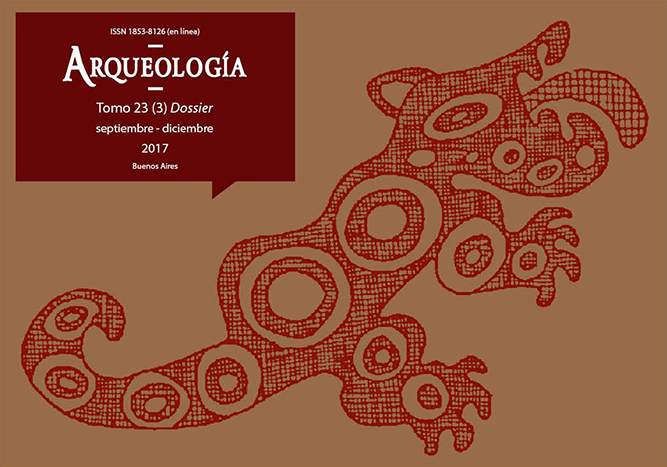Tecnología ósea en la Depresión del Río Salado (provincia de Buenos Aires)
Palabras clave:
Artefactos formales, Tecnología expeditiva, Mamíferos, Aves, Holoceno tardío, Humedal del Río Salado
Resumen
En el humedal de la Depresión del Río Salado –habitado durante el Holoceno tardío (entre 2400 y 400 años AP) por grupos de expertos alfareros– los recursos faunísticos más explotados fueron especies de porte menor como coipo, peces, aves terrestres y acuáticas. Los cérvidos fueron recursos complementarios. Estos grupos desarrollaron estrategias de aprovisionamiento y manufactura de huesos, además de incisivos de coipo, para utilizar como instrumentos. Se analizaron tecno-morfológicamente 25 piezas óseas provenientes de los sitios LG1 (n= 4) y LG5 (n= 21) con evidencias de formatización antrópica. Se tomaron los siguientes parámetros: elemento, tipo de fractura, dimensiones y presencia/ausencia de huellas; asimismo se registró la incidencia de agentes y procesos tafonómicos sobre los elementos. Se identificaron varios taxa: Aves (= 4), Rallidae (n= 1), Mammalia (n= 2), Cervidae (n= 4), Ozotoceros bezoarticus (n= 8), Blastoceros dichotomus (n=1), Rodentia (n= 1), Rodentia cf. Caviinae (n= 3) y Myocastor coypus (n= 1). Se definieron los Grupos Morfológicos: tubos, biseles, puntas (acanalada, semiacanalada, roma) y aquellos que no pudieron asignarse a los ya definidos, se indicaron como indeterminados. Se discuten posibles funciones y se propone que esta tecnología ósea es parte del uso integral de los recursos faunísticos del área.Descargas
La descarga de datos todavía no está disponible.
Cómo citar
Escosteguy, P. D., Salemme, M. C., & González, M. I. (1). Tecnología ósea en la Depresión del Río Salado (provincia de Buenos Aires). Arqueología, 23(3), 65-90. Recuperado a partir de http://revistascientificas.filo.uba.ar/index.php/Arqueologia/article/view/4008
Sección
Artículos
Los autores/as que publiquen en esta revista aceptan las siguientes condiciones:
- Los autores/as conservan los derechos de autor y ceden a la revista el derecho de la primera publicación, con el trabajo registrado mediante Licencia Creative Commons 4.0 Internacional (CC-BY-NC-SA), que permite a terceros utilizar lo publicado siempre que mencionen la autoría del trabajo y a la primera publicación en esta revista.
- Los autores/as pueden realizar otros acuerdos contractuales independientes y adicionales para la distribución no exclusiva de la versión del artículo publicado en esta revista (p.e. incluirlo en un repositorio institucional o publicarlo en un libro) siempre que indiquen claramente que el trabajo se publicó por primera vez en esta revista.
- Se permite y recomienda a los autores/as a publicar su trabajo en Internet (p.e. en sus sitios web personales o en depósitos institucionales), tanto antes como después de su publicación en esta revista, siempre y cuando proporcionen información bibliográfica que acredite, si procede, su publicación en ella. De esta manera, pueden favorecerse intercambios productivos y a una mayor y más rápida difusión del trabajo publicado (vea The Effect of Open Access).



.png)

(1)13.png)






1.jpg)
1.png)
1.jpg)


13.png)
1.png)


(1)1.png)









